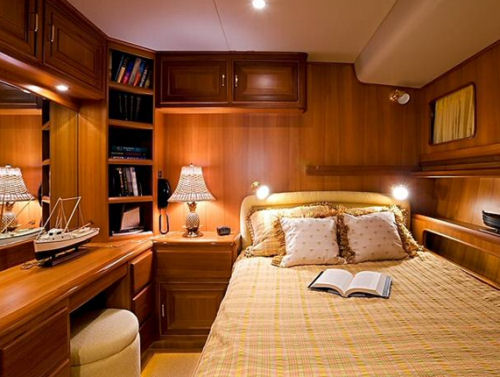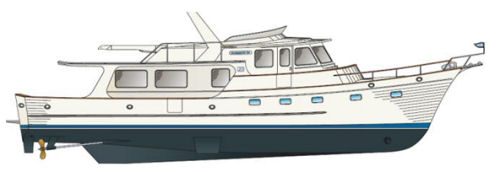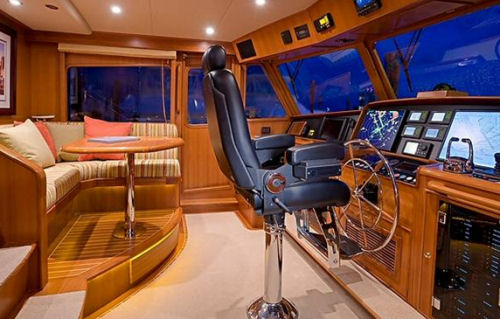Fleming 65 for Worldwide Cruising
In 2006, hull #1 of the Fleming 65 arrived in San Diego and became the personal vessel of none other than Tony Fleming,
the man who started the company in 1985. Tony had decided that he was going to take
this boat on the longest shakedown cruise in history. Now, three years later, 20,000
miles have past under the boat’s keel and Tony has written an account of his cruise
from Alaska to Nova Scotia which we will serialize in the next issues of Offshore
Motoryacht, but first let’s take a look at this very special vessel.

|
|
The Fleming 65 is designed and equipped to take you nearly anywhere you want to go. |
The Back Story
Having built hundreds of cruising boats over his career and interacting with thousands
of boat owners, Tony knows the difference between what looks or sounds good, and
what actually works. On his website he gives his philosophy of boat building—
“The question most manufacturers ask themselves when considering a new feature is
whether it is necessary to include it in order to sell the boat. In the case of
the Fleming, we ask only whether its inclusion will make the boat safer, better
or more convenient. That is why we have introduced literally hundreds or refinements
since we started construction in 1985 and why we continue the process today.”
This sounds like marketing palaver until you look at the boat’s extensive list of
specifications and equipment. Fleming really means it. Let’s take a look at the
Fleming 65, of which about 24 have been built in the last three years:
The Basic Specifications
The first thing I suggest you do when approaching a boat for the first time is to
check her basic specifications and compare them to other boats in her class. This
puts the boat in context with what is on the market. In this case, there are only
a few boats in the same class in terms of displacement, beam and concept. Some of
those are single-engine yachts and some have twin engines with low horsepower.
There a quite a number of 60-something boats that look like they are for long distance
cruising, but when you read the specs you find out they are far lighter than the
Fleming, have relatively big engines, they do not have serious beef and equipment,
and are really intended to be cruised at 20 knots. These boats are in a different
category and are best suited for local coastal cruising.
The Engines
The Fleming 65 has twin 800-hp MAN engines which will push her 18 knots in a pinch,
we are told, but that is not where she is intended to be operated. While she can
cruise all day at 16 knots, her sweet spot is from 8 to 10.5 knots, giving her a
range of about 1,500 nm and 800 nm respectively, according to our calculations using
90% of the 1700-gallon fuel capacity as useable. Tony Fleming tells us that at 8.6
knots she gets about one nautical mile per gallon.
As you will see in the cruising articles by Fleming we will be publishing in the
future, there are times when he puts the pedal to the metal to reach port before
bad weather comes in or to hit a dangerous inlet at the best time.

|
|
This is one of five accommodations plans offered by Fleming in the 65. Note that the main athwartship fuel tanks are exactly in the center of the fore and aft length of the boat. |
Accommodations for Every Need
The Fleming 65 standard versions have three staterooms and two heads, but there
is also a version with three heads. Other versions have a queen VIP on the port
side. We are told by boat builders that the women are usually the ones requesting
a queen in the master. For long distance cruising, a single and a double in the
master serves all purposes and is a lot more comfortable in a seaway, in our opinion.
It also opens up the cabin. With the Fleming 65 you can have it your way.

|
|
This is a functional main deck layout. Note doors port and starboard so that the captain can easily get from side to side. There is also a day head which is a bit unusual on a 65-footer. |
With nearly 250 boats built over the last 23 years and with Fleming’s willingness
to constantly refine and improve on the original design, we suspect that this is
both the most practical and popular of the possibilities. Fleming also has a plan
B.

|
|
The flying bridge is huge and the boat deck takes up half the space which means you can have a large tender, plus you have plenty of room for a kayak, sailboat, and life raft canister. |
Standard Equipment
We urge you to go to Fleming’s website (the link is below) and check out the extensive
list of standard equipment and specifications listed there in detail. I like builders
which do that – it means they care. (I’m often surprised at how many builders do
not go into detail about their specs. It gives me the feeling that either they or
their customers don’t really think the details are very important.)

|
| The guest stateroom is as cozy as you’ll find on any yacht. |
First, let’s talk about the bottom and running gear. The hull has barrier coats
of vinylester resin and epoxy paint below the waterline. That eliminates blistering.
The keel is lower than the four-bladed props so that means if you run aground your
keel -- which has an 8’ long stainless steel shoe -- hits first. The keel is solid
and is glassed over at the top where it joins with the hull, so if you hit hard
and damage the keel you are not going to be taking on water.

|
|
Note that the keel is lower than the running gear. The stabilizers come standard and have 9 sq. ft. per fin. |
There are tunnels in the bottom for the shafts. This design gives the props a more
efficient angle of attack and reduces the draft to 5’. Note that there is not a
big barn door of a transom under the waterline. The bottom comes up to the stern
which means this boat will be easier to handle in a following sea.
Stabilizers by American Bow Thruster are standard and the fin size is 9 sq. ft.
which is designed to maximize their performance at 8 to 10 knots, the kind of speed
one would be making in more rolly conditions.

|
| Note ample room on the boat deck for a large tender, kayak and life raft canister. With a table on the aft deck you can have al fresco dining. |
On Deck
The standard teak deck is 5/8’ thick. This is unusual on two counts: it is standard,
and thick. Over time, holly stoning the teak decks will wear them down. With thick
decks like this you should never have to worry about your teak wearing out. There
are scuppers along the edge of the deck which are piped below to the boot stripe
so you don’t have black streaks on your topsides. Fleming has placed five 14” cleats
recessed into the bulwarks on the side decks, something that you rarely see on
this size boat, in addition to cleats at the bow and stern.
The Engine Room
There are several things that set this engine room apart from most production boats.
First, Fleming uses Delta-T air intake baffles to shut off air to the engine room
in case of fire. The four fuel tanks all have sight gauges and there is a sophisticated
fuel transfer system with digital fuel counter so that you rearrange and polish
your fuel and keep track of how many gallons are in each tank. All tanks have sumps,
and have their own shut-off valves. Fleming has drip pans under the engines -- a
small inexpensive item, but something most boat builders forget.
Fleming has installed a Headhunter pressure-jet toilet system which is the best
on the market. The boat has 330 gallons of black water tankage which is more than
most, far larger, boats have. There are odor filters on the air vent lines, another
thing that is unusual.
The boat comes standard with two Cablemaster units, both in the stern, port and
starboard.

|
|
The pilothouse is a traditional design paneled in teak and has proved its practicality over the years. |
Topsides
Not surprising for a boat that is intended for long range cruising, the pilothouse
is large and well equipped. The captain’s chair is a Stidd seat, something that
is an $8,000 to $10,000 option on most boats. There is a chart table, drawers for
paper charts, and even a drawer for file folders. The windshields are 9mm thick,
meeting CE regulations, and they have defrosters. There is a rudder indicator which
is a simple thing one rarely sees on boats, and there are red lights overhead which
can be dimmed for night running.
These are just a few of the things that caught my eye, things that are a bit out
of the ordinary, but essential for a fully found vessel. Does the boat have everything
it needs for a long passage in foreign waters? Of course not. There is no way for
Fleming to anticipate everyone’s needs, and if it did the boat would be loaded down
with gear most people would not need, and have to be sold for an astronomical price.
Having said that, what are some things we would add?
Important Optional Equipment
Boaters planning on going to Mexico or Central America should consider an Alfa Laval
centrifugal force fuel filter. One captain we spoke with who just spent several
months in Mexico and Costa Rica said he had to clean out his Alfa Laval every three
weeks and each time it was full of crud taken out of the local fuel.
Clearly, long distance cruisers need a watermaker. Fleming tells us that every customer
seems to have a slightly different idea about the brand and the capacity of the
watermaker they want, so the company leaves that as an option. We would get a high
capacity unit, say 1200 gpd, not because we need that much water each day, but the
higher the capacity, the quicker it makes the water you need.
In the lead picture for this article you see the Fleming 65 outfitted with a hardtop
and isinglass. Those two options greatly prolong the season and we like the 360-degree
visibility for there. Everyone – particularly the older generation -- is aware of
the need to protect their skin from the sun's rays and a hardtop is the way to do
that.
A new Fleming 65 sells for about $2.8 million.
If you would like more information about the Fleming 65, or about the 55 or 75 for
that matter, call 949-645-1024.
Visit Fleming Yachts website…